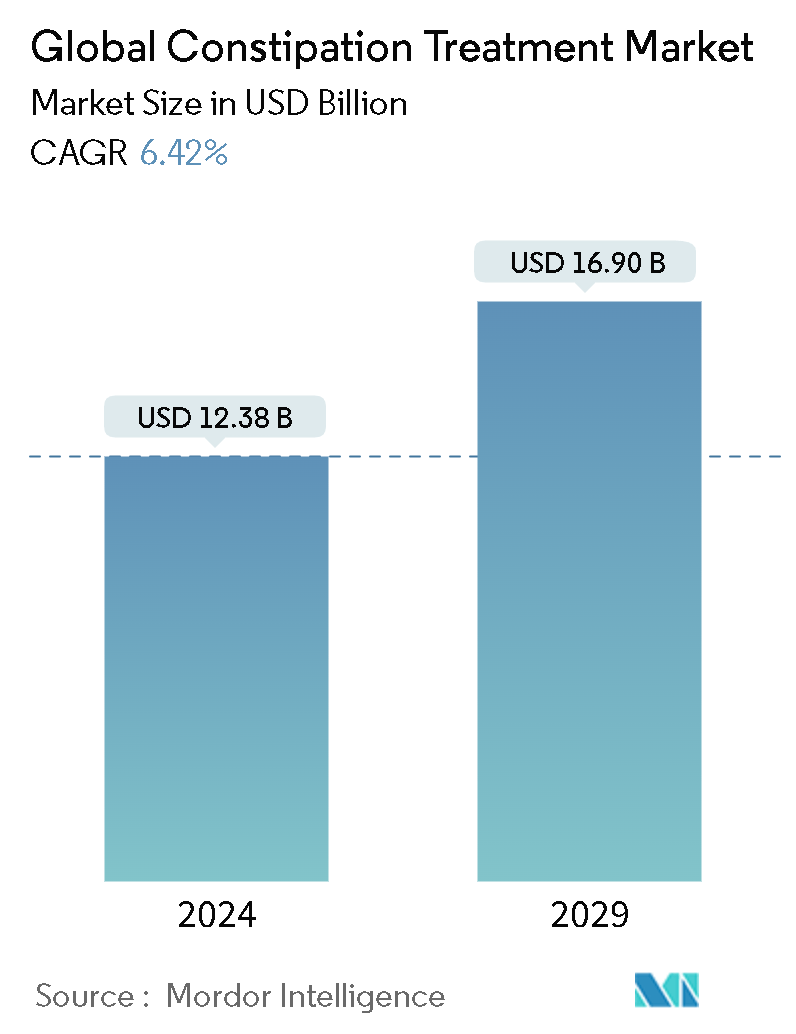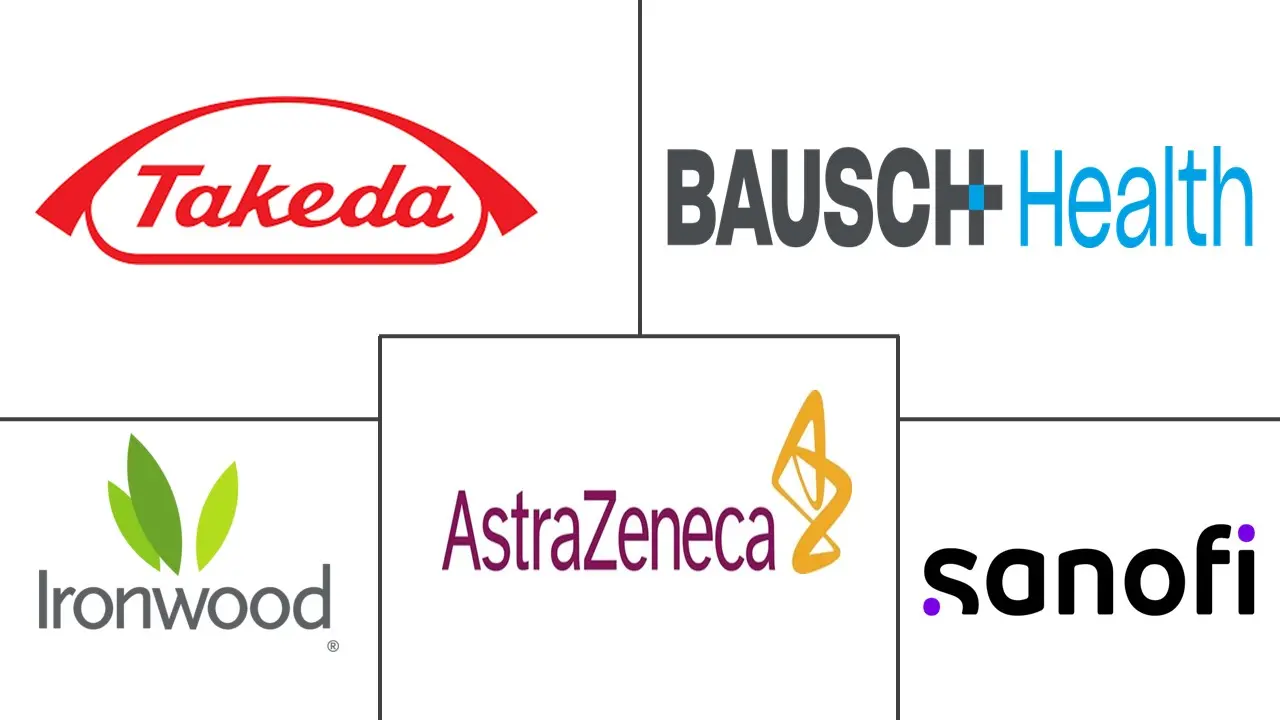Market Size of Global Constipation Treatment Industry

| Study Period | 2019 - 2029 |
| Market Size (2024) | USD 12.38 Billion |
| Market Size (2029) | USD 16.90 Billion |
| CAGR (2024 - 2029) | 6.42 % |
| Fastest Growing Market | North America |
| Largest Market | Asia Pacific |
| Market Concentration | Low |
Major Players
*Disclaimer: Major Players sorted in no particular order |
Constipation Treatment Market Analysis
The Global Constipation Treatment Market size is estimated at USD 12.38 billion in 2024, and is expected to reach USD 16.90 billion by 2029, growing at a CAGR of 6.42% during the forecast period (2024-2029).
The major factor attributing to the growth of the market is the increasing number of geriatric patients and changing dietary habits, the high prevalence of irritable bowel syndrome with constipation (IBS-C), opioid-induced constipation (OIC), and chronic constipation, and the development of the latest drugs and treatment procedures.
These patients use analgesics, such as morphine, hydromorphone, and codeine, as a prescription for chronic non-cancer pain, which has severe adverse effects on the digestive system, resulting in a huge demand for constipation drugs. For instance, as per a cohort study published by the American College of Gastroenterology in November 2023, the prevalence of chronic idiopathic constipation (CIC) is common at 6.0%, while opioid-induced constipation (OIC) was 1.7% in the United States. Moreover, individuals with OIC reported a higher burden of illness concerning symptom severity and prescription constipation medication use. Thus, the huge volume of patient pools with opioid users demands efficient medication for opioid-induced constipation (OIC) ailments, which is likely to fuel the constipation treatment market during the forecast period.
The geriatric population is expected to have a significant impact on the market as people aged above 65 are more prone to chronic diseases. Geriatric people are more prone than younger adults to experience constipation-related issues. A poor diet causes this, as does a lack of sufficient fluids, a lack of exercise, the use of specific medications to treat other medical disorders, and unfavorable bowel habits, which are a few causes of this inclination. In 2022, the United Nations Department of Economic and Social Affairs (UNDESA) reported 771 million people aged 65 or over. This number is projected to increase to 994 million by 2030 and 1.6 billion by 2050. Thus, the growing geriatric population is expected to boost the target market growth over the forecast period due to the increased adoption of constipation treatments.
Furthermore, the rising initiatives from the key market players, such as the launch of innovative products, are anticipated to drive market growth. For instance, in May 2022, EA Pharma and Mochida Pharmaceutical launched MOVICOL HD, a chronic constipation treatment in Japan. MOVICAL enhances water retention in the digestive system. It also increases stool moisture, softens stool volume, physiologically activates colonic peristalsis, and encourages defecation. Therefore, the launch of products increases the availability of new products in the market, thereby contributing to market growth.
However, increasing dependence on the majority of over-the-counter (OTC) drugs and lack of awareness and reluctance among patients due to adverse effects of opioid-induced constipation (OIC) drugs are expected to hamper the target market during the forecast period.
Constipation Treatment Industry Segmentation
As per the scope of the report, constipation is a common medical condition that affects an individual's normal life, and prolonged constipation could be a symptom of more severe diseases and disorders. It is estimated to affect every individual once in a lifetime. Constipation may be occasional, lasting for a few weeks, or chronic, lasting longer and recurrent. Therefore, it may be associated with other conditions, such as irritable bowel syndrome or opioid consumption.
The constipation treatment market is segmented by therapeutics, disease type, distribution channel, and geography. By therapeutics, the market is segmented into laxatives, chloride channel activators, peripherally acting mu-opioid receptor antagonists, GC-C agonists, and other therapeutics. By disease type, the market is segmented into chronic idiopathic constipation (CIC), irritable bowel syndrome with constipation (IBS-C), and opioid-induced constipation (OIC). By distribution channel, the market is segmented into hospitals, pharmacies, retail pharmacies, and online pharmacies. By geography, the market is segmented into North America, Europe, Asia-Pacific, Middle East and Africa, and South America. The market report also covers the estimated market sizes and trends for 17 different countries across major regions globally. The report offers the value (USD) for the above segments.
| By Therapeutics | |
| Laxatives | |
| Chloride Channel Activators | |
| Peripherally Acting Mu-Opioid Receptor Antagonists | |
| GC-C Agonists | |
| Other Therapeutics |
| By Disease Type | |
| Chronic Idiopathic Constipation (CIC) | |
| Irritable Bowel Syndrome with Constipation (IBS-C) | |
| Opioid-induced Constipation (OIC) |
| By Distribution Channel | |
| Hospital Pharmacies | |
| Retail Pharmacies | |
| Online Pharmacies |
| Geography | ||||||||
| ||||||||
| ||||||||
| ||||||||
| ||||||||
|
Global Constipation Treatment Market Size Summary
The constipation treatment market is poised for significant growth, driven by an increasing geriatric population and the rising prevalence of opioid-induced constipation. The market dynamics have been influenced by the COVID-19 pandemic, which initially reduced patient visits but later highlighted the need for effective treatments due to exacerbated symptoms in individuals with comorbid conditions like irritable bowel syndrome. The demand for constipation treatments is further fueled by the adverse effects of analgesics used by elderly patients, who are more susceptible to constipation due to factors such as poor diet, lack of exercise, and medication side effects. The growing awareness and availability of Peripherally Acting Mu-Opioid Receptor Antagonists, which have shown efficacy in treating opioid-induced constipation, are expected to contribute significantly to market expansion.
North America is anticipated to lead the global constipation treatment market, supported by a high prevalence of chronic constipation and substantial healthcare investments. The United States, in particular, holds a dominant market share due to the presence of numerous pharmaceutical companies and ongoing product launches. The market is moderately fragmented, with key players like Takeda Pharmaceutical Company Ltd., Ironwood Pharmaceuticals, and AstraZeneca Plc actively participating in the development and commercialization of new treatments. Recent regulatory approvals and product launches, such as Ardelyx, Inc.'s IBSRELA, underscore the dynamic nature of the market and its potential for continued growth over the forecast period.
Global Constipation Treatment Market Size - Table of Contents
-
1. MARKET DYNAMICS
-
1.1 Market Overview
-
1.2 Market Drivers
-
1.2.1 Increasing Geriatric Population and Changing Dietary Habits
-
1.2.2 High Prevalence of Irritable Bowel Syndrome with Constipation (IBS-C) and Opioid-induced Constipation (OIC) and Chronic Constipation
-
1.2.3 Development of Latest Drugs and Treatment Procedures
-
-
1.3 Market Restraints
-
1.3.1 Increasing Dependence on Majority of Over-the-Counter (OTC) Drugs
-
1.3.2 Lack of Awareness and Reluctance Among Patients due to Adverse Effects of Opioid-Induced Constipation (OIC) Drugs
-
-
1.4 Porter's Five Forces Analysis
-
1.4.1 Threat of New Entrants
-
1.4.2 Bargaining Power of Buyers/Consumers
-
1.4.3 Bargaining Power of Suppliers
-
1.4.4 Threat of Substitute Products
-
1.4.5 Intensity of Competitive Rivalry
-
-
-
2. MARKET SEGMENTATION (Market Size by Value - USD)
-
2.1 By Therapeutics
-
2.1.1 Laxatives
-
2.1.2 Chloride Channel Activators
-
2.1.3 Peripherally Acting Mu-Opioid Receptor Antagonists
-
2.1.4 GC-C Agonists
-
2.1.5 Other Therapeutics
-
-
2.2 By Disease Type
-
2.2.1 Chronic Idiopathic Constipation (CIC)
-
2.2.2 Irritable Bowel Syndrome with Constipation (IBS-C)
-
2.2.3 Opioid-induced Constipation (OIC)
-
-
2.3 By Distribution Channel
-
2.3.1 Hospital Pharmacies
-
2.3.2 Retail Pharmacies
-
2.3.3 Online Pharmacies
-
-
2.4 Geography
-
2.4.1 North America
-
2.4.1.1 United States
-
2.4.1.2 Canada
-
2.4.1.3 Mexico
-
-
2.4.2 Europe
-
2.4.2.1 Germany
-
2.4.2.2 United Kingdom
-
2.4.2.3 France
-
2.4.2.4 Italy
-
2.4.2.5 Spain
-
2.4.2.6 Rest of Europe
-
-
2.4.3 Asia-Pacific
-
2.4.3.1 China
-
2.4.3.2 Japan
-
2.4.3.3 India
-
2.4.3.4 Australia
-
2.4.3.5 South Korea
-
2.4.3.6 Rest of Asia-Pacific
-
-
2.4.4 Middle East and Africa
-
2.4.4.1 GCC
-
2.4.4.2 South Africa
-
2.4.4.3 Rest of Middle East and Africa
-
-
2.4.5 South America
-
2.4.5.1 Brazil
-
2.4.5.2 Argentina
-
2.4.5.3 Rest of South America
-
-
-
Global Constipation Treatment Market Size FAQs
How big is the Global Constipation Treatment Market?
The Global Constipation Treatment Market size is expected to reach USD 12.38 billion in 2024 and grow at a CAGR of 6.42% to reach USD 16.90 billion by 2029.
What is the current Global Constipation Treatment Market size?
In 2024, the Global Constipation Treatment Market size is expected to reach USD 12.38 billion.

